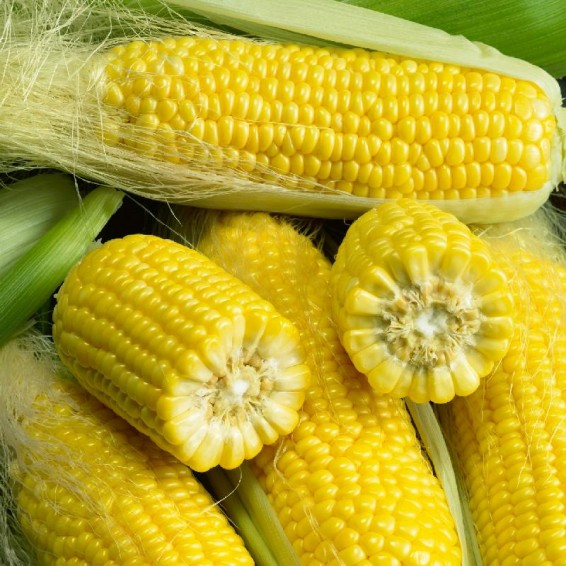Organic Golden Bantam Corn Seeds
Zea mays
- HOW TO GROW
- FAST FACTS
HOW TO GROW
Sowing: Prepare the soil with compost or other organic matter. One week after frost or when the soil consistently reaches 60 degrees F, plant the corn 1" deep and 8-12" apart. Planting blocks of four short rows ensures good pollination. Germination should take place in 5-6 days. For companion planting benefits, plant corn with cucumbers, peas, or pole beans; plants that like shade also do well with corn. Avoid planting tomatoes near corn.
Growing: After the corn emerges, keep it moist and carefully remove weeds; since corn cannot fight against weeds, mulch may be beneficial. Additional organic matter or compost helps growth, since corn is a heavy feeder. Keep in mind that corn has shallow roots which can easily become damaged by hoeing. Watch out for pests, as corn attracts many problematic insects and animals.
Harvesting: About three weeks after the corn silk appears, it will begin to turn brown; this signals that the corn is nearly ripe. When the kernels of sweet corn release a milky substance when pierced, they are ready to be harvested. If the substance is clear, they are not ready; if nothing comes out of the kernel, the optimum time for harvest has passed. Sweet corn usually tastes sweetest if picked in the morning, since sugar content peaks at this time; for best taste, use it the same day it is picked. Golden Bantom also freezes very well.
Seed Saving: Since corn cross-pollinates quite easily with other varieties, seed plants will need to be separated from other pollinating varieties of corn by about 1,000 feet or otherwise prevented from pollinating each other. Allow the seed corn to dry completely on the stalk, until the husk and the stalk have turned brown. If rainy weather comes, cut off the stalks and lay them out in a dry, well ventilated location. Test for dryness by hitting the kernels with a hammer; if they shatter, they are ready for storage. Remove the kernels by running your hands over the cobs; winnow out the chaff. Store seeds in a cool, dry place.
FAST FACTS
Latin Name: Zea mays
Type: Open Pollinated, Heirloom, Warm Season
USDA Zones: 3, 4, 5, 6, 7, 8, 9, 10, 11, 12
Seeds per Ounce: 120
Planting Method: Direct Sow
Planting Depth: 1
Planting Spacing: 8
Row Spacing: 32
Days to Maturity: 75
Sunlight: Full Sun
Height: 60 Inches
Color: Yellow
DESCRIPTION
HOW TO GROW
Sowing: Prepare the soil with compost or other organic matter. One week after frost or when the soil consistently reaches 60 degrees F, plant the corn 1" deep and 8-12" apart. Planting blocks of four short rows ensures good pollination. Germination should take place in 5-6 days. For companion planting benefits, plant corn with cucumbers, peas, or pole beans; plants that like shade also do well with corn. Avoid planting tomatoes near corn.
Growing: After the corn emerges, keep it moist and carefully remove weeds; since corn cannot fight against weeds, mulch may be beneficial. Additional organic matter or compost helps growth, since corn is a heavy feeder. Keep in mind that corn has shallow roots which can easily become damaged by hoeing. Watch out for pests, as corn attracts many problematic insects and animals.
Harvesting: About three weeks after the corn silk appears, it will begin to turn brown; this signals that the corn is nearly ripe. When the kernels of sweet corn release a milky substance when pierced, they are ready to be harvested. If the substance is clear, they are not ready; if nothing comes out of the kernel, the optimum time for harvest has passed. Sweet corn usually tastes sweetest if picked in the morning, since sugar content peaks at this time; for best taste, use it the same day it is picked. Golden Bantom also freezes very well.
Seed Saving: Since corn cross-pollinates quite easily with other varieties, seed plants will need to be separated from other pollinating varieties of corn by about 1,000 feet or otherwise prevented from pollinating each other. Allow the seed corn to dry completely on the stalk, until the husk and the stalk have turned brown. If rainy weather comes, cut off the stalks and lay them out in a dry, well ventilated location. Test for dryness by hitting the kernels with a hammer; if they shatter, they are ready for storage. Remove the kernels by running your hands over the cobs; winnow out the chaff. Store seeds in a cool, dry place.
FAST FACTS
Latin Name: Zea mays
Type: Open Pollinated, Heirloom, Warm Season
USDA Zones: 3, 4, 5, 6, 7, 8, 9, 10, 11, 12
Seeds per Ounce: 120
Planting Method: Direct Sow
Planting Depth: 1
Planting Spacing: 8
Row Spacing: 32
Days to Maturity: 75
Sunlight: Full Sun
Height: 60 Inches
Color: Yellow





